Mark Sisson's Blog, page 280
November 21, 2014
Caveteen Overcomes Unbearable Symptoms with Primal
It’s Friday, everyone! And that means another Primal Blueprint Real Life Story from a Mark’s Daily Apple reader. If you have your own success story and would like to share it with me and the Mark’s Daily Apple community please contact me here. I’ll continue to publish these each Friday as long as they keep coming in. Thank you for reading!
 My whole life, I had horrible gas. It was just how I was, and my parents, siblings, and I all accepted it as normal. As I got older and accumulated a good deal of good friends, this began to be more and more problematic. I would find myself feeling like my gut was near bursting because I would hold this in during school to avoid social excommunication. On top of that, I had the WORST allergies. I could barely go outside without sneezing a ton, having an itchy nose, ears, and throat, or having a stuffy nose and itchy skin. Even indoors I would sneeze all day long. I had to put the tissue box and trash can next to my desk on occasion. It sucked—it really did. I don’t know how I would have lived my life that way.
My whole life, I had horrible gas. It was just how I was, and my parents, siblings, and I all accepted it as normal. As I got older and accumulated a good deal of good friends, this began to be more and more problematic. I would find myself feeling like my gut was near bursting because I would hold this in during school to avoid social excommunication. On top of that, I had the WORST allergies. I could barely go outside without sneezing a ton, having an itchy nose, ears, and throat, or having a stuffy nose and itchy skin. Even indoors I would sneeze all day long. I had to put the tissue box and trash can next to my desk on occasion. It sucked—it really did. I don’t know how I would have lived my life that way.
Around age eight I was tested for celiac disease. The results came back negative, which led me to seek out an allergist. I was diagnosed with an allergy to every form of pollen for which they tested, and was prescribed with a cornucopia of allergy medicines, one of which was the size of a quarter (but much thicker). None of this worked, so eventually (around age 11) I went to a naturopath/acupuncturist who diagnosed me with dysbiosis of the gut, and put me on a yeast cleanse. I had to avoid all sugar (sweets, fruit, etc.) but still include plenty of complex carbs for whatever reason. I followed blindly, yet strictly, and did feel somewhat better afterwards. After this, I continued to deal with moderately bad gas, and my allergies would still get very bad certain seasons.
I was fairly neutral with food (eating/snacking as I was hungry) and completely oblivious to its effects on my health. The kicker is the fact that I was a vegetarian much of my life after age seven, purely because of my taste preference. I defended my decision because I thought it was based on a “healthy avoidance of fat and cholesterol from red meat,” though I had no idea what I was talking about. Obviously it’s not very difficult for someone from age 7-14 to buy into conventional wisdom and all it entails.
In the summer of 2012, a family friend suggested that I go gluten-free (GF), dairy-free (DF), and sugar-free as it greatly helped her son. I was fairly skeptical, especially as I had a negative celiac test and loved sugar. I became almost entirely dairy-free, significantly limited gluten my intake, but kept sugar in my diet. Health was not exactly an appealing term, nor is it by any means today. I, like probably many others, saw health as a generic way to be better than everyone yet eat disgusting food. I was horribly mistaken but had no clue what health REALLY was. Paleo health is near-optimal bodily function with no problems.
So I continued to eat this way, partially GF/DF, until the summer of 2013. My health was continuously getting worse and worse. I was having chronic headaches (which everyone knows really suck), getting acne (that was “normal”), etc., etc., and worst of all, having chronic, uncontrollable bad gas and debilitating allergies. Unlike before, I began to have horrible migraines that would have me bed-ridden and nauseous, and I would occasionally actually throw up. I knew something was very wrong, but I didn’t quite know what. At a certain point, I figured my lack of adherence to GF/DF was a possible cause, so I decided to give it a complete go. I only ended up completely maintaining GF, but stayed mostly DF.
I was having such great trouble living with my body, the burden of these symptoms weighing me down from enjoyment, and I was unable to shrug them off despite every attempt. Previously I had been only casually attempting to find a solution, but now I went into high gear. I began spending much of my free time looking for a cure. I spent hours upon hours, months upon months, many nights until 3am scouring the internet for a cure. I would input my symptoms, look for a condition and then look for a cure for that condition. I would have attempted to use Western medicine, except it had already failed me despite all of its attempts.
I became convinced that the cause of the thing I was trying to cure, bad gas, was a “damaged gut.” I didn’t really know what that meant, but it propelled me onto a search for anything that could heal a damaged gut. I came across a variety of supplements and herbal remedies, nothing diet-related. Despite all of the time and effort I put into this, NOTHING worked—no enzymes, herbs, etc. I finally got an appointment with a gastroenterologist and hoped this would bring me the answers. The problem was that it wasn’t for a month or so, and I wasn’t prepared to wait that long.
In this summer of 2013, when I became completely GF (which didn’t help much at all), my symptoms were sometimes UNBEARABLE. I would literally sometimes be gassing all…day…long. My allergies often made it impossible to think (forget about maybe being happy or enjoying my life). I went into the school year suffering from all of this, plus, I was at a new school for high school. My headaches were very bad—daily at this point. In November 2013, I had a headache that persisted for two weeks, making me unable to focus in class. One day I came home, unable to do anything, lied down and cried, and my mom decided to take me to the emergency room rather than wait for the scheduled doctor’s appointment (not the gastroenterologist). They laid me down for five hours and pumped into my blood a saline IV and some drug combination used to “break migraines.” This was probably one of the worst experiences of my life (having never been in a hospital bed before), yet one of the greatest reliefs I’ve ever felt. The worst part was that I didn’t think I had any control over this.
At last, what I now recognize to have been the most important turning point in my life, I found a lead. It was now December 2012, and I had been continuing to helplessly suffer from flatulence. There was a small lead on an endurance biker’s blog who had used the “Whole30″ to heal his gut. I wanted to see what it was, but not have to pay for it, so I went google-crazy. I found Nerd Fitness, Balanced Bites, The Paleo Mom, Paleo Leap, The Paleo Diet, Robb Wolf, Chris Kresser, etc., and my personal favorite, Mark’s Daily Apple. I learned about the paleo diet—what it was, how it worked, and how I could do it. I was extremely eager just to try it, since, apparently, it said I could fix my problems in 30 days—a cure that I might have given my left hand for (not completely joking, either). As Robb Wolf calls it, the “greasy used-car sales pitch” is likely what sucked me in. 30 days? No problem.
Cutting everything out was easy, really. With the desperation I faced every day, I would’ve done anything. The problem was that I was still mostly vegetarian, only having gained a taste for chicken. I did eat eggs, so those two things became my dietary staples (chicken curry, shredded chicken, paleo mayo, salt/pepper, curry powder, chopped grapes and pecans, and carrot sticks for dipping—really good stuff). Anyway, I implemented this diet, and finally had a world of research to look through. The more and more I read from these paleo/primal sites, skeptically cross-checking the claims and references, I had drunk the cool-aid (correct grammar—had to look it up), along with all of its sweet truths.
January 2014 was more or less my Whole30. I was never committed to the Whole 30, but I was certain that I wanted to stick with this paleo thing for life. It all made so much sense and I just continually realized how much more important life was to me than food. Not to mention, this food is pretty darn tasty because it is exactly what our hormones have developed to want.
After a month I still had some problems, likely because the Whole 30 wasn’t enough to correct the gut imbalance and leaky gut that I had developed. So I had to “Break the Vicious Cycle.” I found the GAPS diet and thought it was best for me, but I eventually realized it was too much. It was too strict for me to handle on my own. I must throw in, I have done all this research myself, but I have an awesome, very supportive mother who helps me however she can, despite being a busy single mother of four.
After the practically traumatizing experience with GAPS, I fell off of the wagon for a long while, basing my eating on paleo but never being able to fully stick to the diet to the extent necessary to correct my flora and heal my gut. I’m fairly certain I even developed an eating disorder—I would go from a diet (meant to heal my gut and correct my flora imbalance) where I felt deprived, to eating a bunch of ice cream and crap on the weekend. I always stayed away from grains, gluten, legumes, and vegetable oil, but I would just go headfirst into sugar. This was likely due to a combination of personal problems and a lack of confidence in my diet, losing sight of my goals in essence.
Regardless, I still felt much better than I had, maintaining a mostly primal diet and keeping up the search for a way to end once and for all the SIBO symptoms of occasional gas and bad breath that continued to plague me for a while. I also wanted the answer to why I was NEVER satisfied after meals. I am now on my own personal diet, limiting all fermentable substrates as per the Fast Tract Diet, and attempting to reset my leptin hormones as per Jack Kruse’s recommendations.
 I continue to feel better, knowing that my old self is merely dust in the wind, and my newfound body is the one in which I will enjoy my existence and treat well for as long as I live. At this point, I have probably spent hundreds of hours reading and researching ancestral lifestyle related things and know more than most people alive. I have boundless energy, and am the only kid in my school that bikes to school, even being one of the furthest away (5 miles each way). I sleep extremely well, waking up quite refreshed every day. Every meal I eat tastes like the best I’ve ever eaten, and I prepare every single one myself, leading me to consider a backup career as a chef as a strong possibility. I am implementing all aspects of Primal Fitness, walking as much as possible, doing the weight exercises, and sprinting. I still have a little way to go in my path to achieving an optimal body from my previously damaged, vegetarian and grain-based self, but I know what I want and I am certain of how I will get there. Most importantly, I am able to enjoy life with a body that functions the way it is supposed to.
I continue to feel better, knowing that my old self is merely dust in the wind, and my newfound body is the one in which I will enjoy my existence and treat well for as long as I live. At this point, I have probably spent hundreds of hours reading and researching ancestral lifestyle related things and know more than most people alive. I have boundless energy, and am the only kid in my school that bikes to school, even being one of the furthest away (5 miles each way). I sleep extremely well, waking up quite refreshed every day. Every meal I eat tastes like the best I’ve ever eaten, and I prepare every single one myself, leading me to consider a backup career as a chef as a strong possibility. I am implementing all aspects of Primal Fitness, walking as much as possible, doing the weight exercises, and sprinting. I still have a little way to go in my path to achieving an optimal body from my previously damaged, vegetarian and grain-based self, but I know what I want and I am certain of how I will get there. Most importantly, I am able to enjoy life with a body that functions the way it is supposed to.
Anyhow, I know that a genetically concordant lifestyle is right for me, but feel that it is my calling to help others. NO ONE should have to suffer the way that I and so many other have simply out of conventional wisdom and ignorance. People should also know that there is a better alternative way to live, and it’s possible to not have headaches and acne, or not be constantly hungry and randomly tired, etc. I will do anything I can with my life to perpetuate the primal ideas and help people to recover from, and not fall victim to, the “ailments & diseases of modern life.”
Matt
You CAN Lose Weight and Get Healthy. Find Out How>>



November 20, 2014
Change Coming to the Dietary Guidelines for Americans?
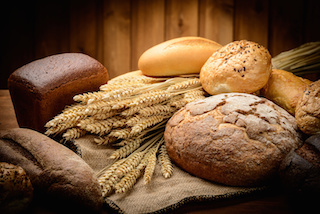 It’s about that time again, folks. The sixth meeting of the 2015 Dietary Guidelines Advisory Committee has recently drawn to a close. Just one more meeting remains until the absolute final word on how to eat healthily and stave off chronic disease, obesity, and early death forever becomes available for public consumption. Isn’t it grand? We can all just sit back, turn off our brains, close down the PubMed tab, and receive premier nutritional recommendations that do all the work for us. I’m serious. Stop thinking so much. The impending recommendations come from high up: a Committee composed of Important People and Experts with your best interests in mind.
It’s about that time again, folks. The sixth meeting of the 2015 Dietary Guidelines Advisory Committee has recently drawn to a close. Just one more meeting remains until the absolute final word on how to eat healthily and stave off chronic disease, obesity, and early death forever becomes available for public consumption. Isn’t it grand? We can all just sit back, turn off our brains, close down the PubMed tab, and receive premier nutritional recommendations that do all the work for us. I’m serious. Stop thinking so much. The impending recommendations come from high up: a Committee composed of Important People and Experts with your best interests in mind.
Well, that’s what they want you to think. In reality, these guidelines are likely going to have a lot of shortcomings, inconsistencies, and outright errors – just like the previous guidelines – and they deserve criticism and scrutiny.
The Healthy Nation Coalition, whose director is Adele Hite, talented purveyor of the brilliant Eathropology blog, has produced a scathing letter detailing the specific shortcomings, failings, and falsehoods found in the past and likely future Dietary Guidelines. Though it’s addressed to Tom Vilsack of the Department of Agriculture and Sylvia Burwell of the Department of Health and Human Services, the Healthy Nation Coalition’s true target audience is “broad-based and includes scientists, health care practitioners, ranchers & farmers, health advocacy groups,” and people like you guys. You can read it here.
So, what’s their beef with the Guidelines? The Coalition’s letter submits five points of contention. I’ll go through each one of them in turn.
They have contributed to the increase of chronic diseases.
Since 1977, the Dietary Goals have suggested that Americans interested in living longer and avoiding chronic diseases like diabetes and cancer should eat less saturated fat and cholesterol from animal foods and eat more grains (and grain products) and vegetable oils. That message has never changed. The Food Pyramid held firm, even amidst growing rates of the diseases it was supposed to prevent.
Critics contend that Americans simply didn’t Pyramid hard enough. They say we didn’t follow the guidelines, and that’s why disease increased. There’s a glimmer of truth there. Americans don’t eat the recommended number of vegetable servings a day, for one. But by and large, we have heeded the main recommendations stressed by the Committee: we reduced the amount of saturated fat and cholesterol in our diets (from foods like eggs, whole milk, butter, and red meat) and increased our consumption of grains and vegetable oils.
They have not provided guidance compatible with adequate essential nutrition.
The guidelines focus too much on what not to eat (animal products). And when they do tell us to eat certain foods, their advice is predicated on what those foods do not contain (cholesterol, saturated fat). There appears to be a basic disregard for the essential requirements of human nutrition.
One hilarious example (that I’ve pointed out in the past) is that the sodium guidelines are completely incompatible with the potassium guidelines. The guidelines for sodium and potassium intake cannot be met simultaneously. The esteemed experts want you to eat in a way that is literally impossible to accomplish.
Another is the total absence of any mention of choline, despite its official categorization as an essential micronutrient in 1998. We get that it’s found in scary foods like eggs, liver, and meat, but since it appears to be highly protective against the development of fatty liver disease, you’d think it’d get at least a cursory mention. But nope.
They also ignore the meager results of trials of the recommended low-fat diet in children. Kids don’t have much control over what they eat. They eat what the parents eat. And when kids eat the low-fat diet promoted by the guidelines, their intake of several vital nutrients – magnesium, calcium, zinc, vitamin E, phosphorus, vitamin B-12, niacin, and riboflavin – suffers. That could have disastrous effects on the lifelong health and development of these children. Heck, it probably already has.
They represent a narrow approach to food and nutrition inconsistent with the nation’s diverse cultures, ethnicities, and socioeconomic classes.
We’re a nation of many cultures, ethnicities, and classes. Different genetic background, family histories, and access to foods changes our response to the guidelines. A wealthy family with one breadwinner and all the time in the world to cook at home might get away with a low-fat, Guideline-compliant diet. They’re shopping at Whole Foods, cooking with extra virgin olive oil, baking real sourdough at home (or buying it for $10 a loaf from the eccentric baker at the farmer’s market), eating wild salmon, and having the occasional meal of grass-fed beef. Not ideal, but not terrible, right? If you’re a single parent juggling a couple jobs and barely skating by, your low-fat, Guideline-compliant diet consists of white bread, jugs of corn oil, fish sticks, and vegetarian burritos from Taco Bell.
Ethnicity matters, too. One example is that black Americans gain far more weight on the Guideline-compliant diet than white Americans, who already gain a fair amount themselves.
Also, avoiding saturated fat, cholesterol, and animal products in general eliminates the inclusion of certain traditional and healthy aspects of ethnic cuisines. Mexican cuisine’s lard and chorizo and eggs? No dice. Indian Americans’ ghee? Absolutely not. Pretty much the entirety of soul food is off limits, and good luck sneaking traditional Jewish liver paté through your restricted Guideline-compliant diet. The worst part is that these Guidelines are having an effect. I can’t recall how many times I’ve gone to an Indian restaurant or taqueria, asked if they cook with “real ghee/lard” and got horrified looks from the managers. Either that or they say “Oh, no! Of course not! 100% cholesterol free vegetable oil is all we use!” under the assumption that I’m trying to avoid, not seek, restaurants that cook in ghee or lard.
They are based on weak and inconclusive scientific data.
If the guidelines were based on solid evidence, and people just weren’t doing it right, that would be one thing. But the evidence used to support the guidelines isn’t settled; it’s error-riddled and ignores counter evidence.
They claim that saturated fat raises the risk of heart disease, even though the most recent meta-analyses find no relationship between the two. Some studies even find inverse relationships between saturated fat consumption and progression of atherosclerosis.
They claim that dietary cholesterol increases the risk of heart disease, even though a joint meeting between the AHA and the American College of Cardiology decided to drop the restriction on dietary cholesterol.
They claim that PUFA oils reduce the risk of heart disease and should be the primary source of fat in the diet, even though an updated meta-analysis incorporating recovered data from past “pro-PUFA” trials concluded that “substituting dietary linoleic acid in place of saturated fats increased the rates of death from all causes, coronary heart disease, and cardiovascular disease.”
They claim that high-carb diets reduce the risk of chronic disease, ignoring research attributing beneficial changes of disease blood markers to low-carb diets and the admission of a former Guideline Committee chair that “evidence has begun to accumulate suggesting that a lower intake of carbohydrate may be better for cardiovascular health.”
They claim a low-sodium diet reduces the risk of chronic disease, even though a recent report from the Institute of Medicine found insufficient evidence to support the sodium guidelines for African-Americans of any age and adults over 50.
And they have expanded their purpose to issues outside their original mandate.
Originally, the Guidelines were simple recommendations about what to eat for good health. Wrongheaded, but mostly harmless. Today, they inform federal regulations, school lunches, agricultural policy, and budget allocations. They dictate nutritional research. And yet there’s no accountability. No one is tracking the rates of obesity and chronic disease to determine whether the Guidelines are actually working (they’re not, clearly).
The Heathy Nation Coalition offers a series of solutions that look pretty solid to me. They want guidelines that are based on sound science, work for all Americans (not just the wealthy), include traditional foods (even if they contain scary nutrients like saturated fat and cholesterol), allow for research into special populations and health conditions, focus on health (not just bodyweight), and make sense of seemingly contradictory dietary advice.
Even if this letter doesn’t reach the Committee, let alone change the content of its recommendations, it’s still going to change how thousands of people think about their own diets. Anyone who reads it will think twice about assuming the official recommendations are sound and ironclad.
So, today, go ahead and put your name on that list if you agree with the letter and its criticisms and suggestions. Send it along with the other tens of thousands of food eaters out there who want to continue to eat the way they like and the evidence – the actual evidence – suggests is sound. Post it to your Facebook timeline. Put it up on your health food store’s bulletin board. This isn’t about setting out to change the world. That will only end in disappointment. Instead, provide the tools for change to the people close to you. If everyone can help one, two, or more people discover that the official dietary guidelines are based on poor science and that better ways exist, widespread change will happen organically.
I think sharing this letter might be a nice, simple, concise way of doing that.
What about you, folks? What do you think about the letter? Let’s get this thing moving!
Prefer listening to reading? Get an audio recording of this blog post, and subscribe to the Primal Blueprint Podcast on iTunes for instant access to all past, present and future episodes here.
You CAN Lose Weight and Get Healthy. Find Out How>>



November 19, 2014
How to Support Healthy Skin Bacteria
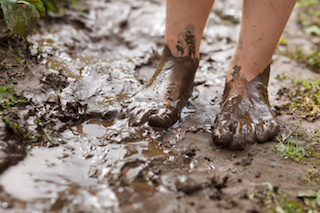 Last week, I introduced the concept of the skin biome: the vast communities of microbes living on and in our skin. For some, it was unsettling. Gut microbes are out of sight, out of mind. But skin microbes are on us. They’re crawling, reproducing, digesting, and secreting various fluids and lipids all over the surface of our bodies. In people who’ve been conditioned to use soap and water to remove every last trace of bacteria from our hands and skin, the idea that our hands, faces, arms, and torsos are teeming with microbes – and that it’s probably unwise to remove them all – is hard to swallow. We might even recoil at the thought. I mean, viruses and mites living on us? Really?
Last week, I introduced the concept of the skin biome: the vast communities of microbes living on and in our skin. For some, it was unsettling. Gut microbes are out of sight, out of mind. But skin microbes are on us. They’re crawling, reproducing, digesting, and secreting various fluids and lipids all over the surface of our bodies. In people who’ve been conditioned to use soap and water to remove every last trace of bacteria from our hands and skin, the idea that our hands, faces, arms, and torsos are teeming with microbes – and that it’s probably unwise to remove them all – is hard to swallow. We might even recoil at the thought. I mean, viruses and mites living on us? Really?
Yeah. And we need them to be healthy and vibrant because skin bacteria help determine our skin’s immune response, vulnerability to allergies, wound healing, and susceptibility to certain skin diseases, to name just a few things they do for us.
We have a pretty good idea how to cultivate a healthy gut biome. We may not know everything (and we probably never will), but fermented foods, prebiotic fibers, and nutrient-dense fat, protein, and carbohydrate sources are a good start.
How about cultivating a healthy skin biome?
You pick up a lot of your skin bacteria from environmental contact. For example, you’re more likely to share skin bacteria with your spouse, your roommates, your pets, and your friends than with strangers. One recent study into the skin biome changes of roller derby players found that, after matches, opposing teams shared many skin biome similarities that didn’t exist before. They’d swapped bacteria.
Your home’s biome has an impact on your own. Low bacterial diversity in one’s immediate surroundings is linked to skin diseases and subsequent lower skin bacterial diversity. I don’t know if you need to go so far as to sequence the biome of your bedroom (or if that service is even commercially available), but if you’re having skin issues your home might need a deep-cleaning. Consider trying a probiotic household cleaner. There’s no real research – yet – but the concept is sound: instead of sterilizing the house with traditional cleaners that leave it open to recolonization by pathogens, introduce beneficial microbes that prevent recolonization.
Avoid antibacterial soaps and lotions. You’re already doing this, probably. Triclosan, the principle antibiotic found in antibacterial soaps, has received lots of negative press, even in the mainstream. It crosses the placenta and induces antibiotic resistance. But make sure you’re not using it. Check your labels for anything resembling “anti-bacterial.”
Consider probiotic lotions. One lotion containing Enterococcus faecalis SL-5 reduced acne lesions and countered the effect of acne-causing bacteria. You could make your own, too. Seriously: researchers just added E. faecalis SL-5 probiotic powder to a commercial lotion to produce the anti-inflammatory effect. However, I’m not yet sold on the idea that probiotic lotions are necessary (or even helpful) in the absence of skin problems.
Get a dog. Dog owners have less eczema, even if they have a dog allergy (the same is, sadly, not true for cat owners with cat allergy), most likely since dogs tend to roll around in everything they encounter and rub against us any chance they get, thereby increasing the microbial diversity of our homes and mixing their rich skin bacteria with ours. Dogs are filthy, and that’s probably a good thing.
Roll around in the dirt. Okay, not literally. Gardening, playing outdoor sports that involve intimate contact with the soil, and making mud pies are all somewhat more socially acceptable alternatives to taking dirt baths like a hog. Then again, horses, pigs, dogs, and birds may be on to something with their tendency to roll around in the soil. So, I dunno – try it?
Try AOBiome spray. AOBiome is a probiotic body spray that promises to replace soap. Rife with the same ammonia-consuming bacteria abundant in soil and fresh water (which is why you should roll around in the dirt sometimes), it colonizes your body with bacteria that consume sweat and leave you feeling so fresh and so clean. Some months back, a NY Times writer tried it for a few weeks, foregoing soap, shampoo, and deodorant entirely. It went mostly well. Her skin improved, buoyed by the natural oils soap normally washes away. While she didn’t smell bad, she had an odor that she wasn’t used to smelling. We’ve been conditioned to fear any and all body odors, which I think is a mistake.
Wash your hands with soap, but don’t be so liberal with other parts of the body unless they really need it. Handling raw chicken? Yeah, wash up. Flu going around? Wash up. Out hiking? Regular soap isn’t chemically antibacterial, so using it won’t promote antibiotic resistance or wage chemical warfare on the good guys, but it does physically bind and slough off microbes. For myself, I’ve cut way back on soap and shampoo usage. I shower daily, but use soap only about every other time, mostly to wash off chlorine (I’m in the pool almost every day), and shampoo about once a week. Salt (from ocean plunges) and dirt (from playing Ultimate and general cavorting and frolicking) don’t worry me. If I’m sweaty, from a hard workout, water does the trick. And you can ask anyone who’s attended PrimalCon, where I give out hugs quite liberally: I don’t stink (do I?).
Limit or avoid antiperspirants. Using them reduces microbial diversity of the armpit, and they probably just make you smell worse in the long run. Sweating is a natural physiological process; it’s unwise to curtail it by literally clogging the sweat pores with aluminum. Scientists have dubbed armpits the “rain forests” of the skin biome. They’re a powerful source of microbial diversity. I almost wonder if taking armpit swabs from healthy individuals and applying them to parts of your skin afflicted with dryness or eczema could have an alleviating effect. Wouldn’t be surprised and it couldn’t really hurt. And actually, researchers from that armpit study have done that, transplanting armpit bacteria from people who don’t really smell to the armpits of people who do smell. They’ve gotten great results, according to the above article. Anyone want to try?
Though you might think only the topical application of antibiotics would impact the skin biome, oral usage has an effect. Oral antibiotics given to mice with skin wounds reduced the diversity of wound bacteria and dampened the immune response, thus delaying wound healing.
Get comfortable with the idea of “bacteria” on your skin. This is the hardest, most important step to take. The knee jerk reaction to “bacteria” is a negative one. It shouldn’t be, as the last two posts have shown. If you can accept the place bacteria have on your body, maybe you won’t feel the need to scrub down twice a day and rub lotions all over.
As time goes on and research continues, we’ll learn more about healthy practices for a healthy skin biome. For now, though, these are simple, effective strategies that almost anyone can experiment with.
Let’s hear from you guys, now. What are you hygiene habits like these days? How much soap do you use? Are you quick to wash every last speck of dirt from your skin? How’s your skin health?
Thanks for reading, everyone!
Prefer listening to reading? Get an audio recording of this blog post, and subscribe to the Primal Blueprint Podcast on iTunes for instant access to all past, present and future episodes here.




November 18, 2014
8 Strategies for Cultivating a Vitality Mindset
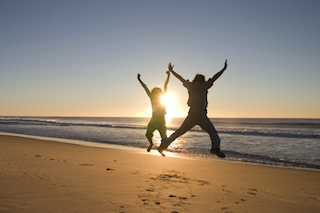 When people say their goal is “to get healthy,” most of the time they mean implementing a few diet and exercise strategies to get a particular targeted result. They’re referring to a practical, circumscribed process. They may recognize that they’ll have to keep up some of the efforts long after the number on the scale registers their goal or their biceps look a certain way, but there’s not much of an expansive vision. I’m all for pragmatism, but I feel it can be rather constrictive. Even the word “health” itself has been watered down practically speaking. Health, too often, is used as some relative term more descriptive of an absence of obvious ill symptoms than the kind of well-being I’m after. It smacks of problem-solving rather than growth. Vitality, on the other hand, ups the ante considerably. It suggests living from a different, more energetic, more fulfilling place. To achieve it, however, requires a bigger, deeper commitment than achieving a lukewarm sense of health. It has the power to change us on deeper, further-reaching levels. It’s more challenging and less easily contained, but the rewards are much more considerable. Reaching for vitality is as much about mind as it is matter. What does fostering a vitality mindset, however, look like? What strategies get at the heart of the endeavor?
When people say their goal is “to get healthy,” most of the time they mean implementing a few diet and exercise strategies to get a particular targeted result. They’re referring to a practical, circumscribed process. They may recognize that they’ll have to keep up some of the efforts long after the number on the scale registers their goal or their biceps look a certain way, but there’s not much of an expansive vision. I’m all for pragmatism, but I feel it can be rather constrictive. Even the word “health” itself has been watered down practically speaking. Health, too often, is used as some relative term more descriptive of an absence of obvious ill symptoms than the kind of well-being I’m after. It smacks of problem-solving rather than growth. Vitality, on the other hand, ups the ante considerably. It suggests living from a different, more energetic, more fulfilling place. To achieve it, however, requires a bigger, deeper commitment than achieving a lukewarm sense of health. It has the power to change us on deeper, further-reaching levels. It’s more challenging and less easily contained, but the rewards are much more considerable. Reaching for vitality is as much about mind as it is matter. What does fostering a vitality mindset, however, look like? What strategies get at the heart of the endeavor?
Decide what vitality means for you (and be willing to continually upgrade that definition).
Vitality is, of course, a different and, I think, much higher standard than longevity. It’s maximizing the activity and actualization levels of all our years by making a healthy lifestyle our lifelong commitment. While longevity is about achieving a higher age, putting the emphasis on our future, vitality fixes our focus on the here and now. What would it mean to experience vitality today?
In keeping with that idea, ask yourself what you’re willing to commit to today. Be honest, but don’t shirk all sense of self-challenge. Vitality will be nothing but a pipe dream if you don’t invest yourself in it – invest your time, your energy and (yes, to some degree) invest your money. Ask yourself what you want out of this investment. What do you want to see happen? How do you ultimately want to live? The answer is likely different for everyone.
That said, I think people all too often grossly underestimate what’s possible for them. They can envision improvements that would make life slightly better than it is today – not getting winded walking up stairs, being able to keep up with their children or grandchildren, completing a 5K. These are great goals. Just be prepared to outgrow them. Allow yourself to define your own vision of vitality, but commit to revisiting that vision periodically – accepting and anticipating more for yourself as you grow into the process. This leads me to…
Do the personal work around deserving.
I’ve said it before, and I’ll say it again here: our stories are too often our greatest barrier. Over the course of our lifetimes we’ve absorbed the claims, words and assumptions of other people. We’ve used them as our mirrors.
To accept genuine change into our lives, we have to be willing to deserve it. We have to feel it’s our birthright – and it is! I’m not trying to sound romantic or biblical here. It really is pretty simple actually. People will rise to the level of their own expectations for themselves. Sure, you might have an incredible trainer who builds you up for six months, but if you don’t have the self-esteem to support the changes that happen, chances are you’ll descend back to a level of health/fitness/weight/well-being that your unconfident self is comfortable with once you’re not paying that trainer anymore. You won’t be able to live with the incongruence between the success you see in the mirror and the success you feel you deserve.
Recognize that genuine well-being is a personal value.
Don’t shortchange this process. Going on a diet is a strategy for a particular end. Choosing a vitality mindset (and healthy, vibrant life) is a personal value. Your daily decisions and logistical strategies will help you put that value into action. I’d consider this a critical distinction.
We don’t identify with strategies. They’re tools, tricks we use for utilitarian purposes. Values (e.g. dedication to family, strong work ethic) are part of our substance. We see them as part of our identities and even integrity. Cultivating a vitality mindset means accepting that health is more than an interest. It’s part of our inner fabric. Compromising our health means compromising who we are and what we hold dear.
With that thought in mind, we learn to realign the logistics of our lives to favor our vitality. We make choices (both major and minor) that feed our vitality. We become open to new solutions and approaches to facets of everyday living. We recognize that many things – even “big” things in life – are worth sacrificing before our health. Our well-being is the base from which we build our lives and foster what we have to offer others. To learn to make decisions based on that fundamental value.
Accept the countercultural dimension of life going forward.
From a young age, we’re taught to go after what’s popular, and the message permeates into adulthood. The most obvious caricature of this pattern we see in the throngs of people lining up at 3:00 a.m. to stampede through the doors on Black Friday, unconcerned about trampling or otherwise maiming other people – for the latest this or that. More subtle but still distorting versions come out in how much of our lives we’ll sacrifice to hold jobs that give us the bigger, “better” possessions, the nagging insecurity that fuels decisions to keep up with the neighbors and the instinct to fit in by participating in the the choices and activities that others set up during social interactions and events.
The more developed and personalized your sense of vitality is, the more easily you’ll distinguish what is your desire versus what is social influence. Learn to live with the social discomfort and step out with your priorities as much as you desire. (No need to be the Primal poster child if you just want to enjoy your lunch in peace and quiet.) Tell people tactfully why you’re not partaking of certain foods or activities as often as you want. Let it go when you want to do that. You get to choose your life and values. You don’t owe anyone an explanation.
Choose an abundance mentality.
In any life situation, we can see the cup as half full or half empty. We might anticipate missing x, y or z in going Primal. We can fixate on it if we truly want to, in fact. We can tell ourselves we’re making a huge sacrifice and kick up a dust cloud of stress and resentment. At the end of the day, we’ll have given our energy to a sense of lack and missed the chance to see what’s available to us.
Alternatively, we can relish the options and conditions that a Primal life offers. We can gather a new collection of cookbooks. We can pride ourselves in developing new capacities at the gym. We can recognize that we’ve never slept better or felt more emotional equanimity. We can be grateful for the changes we’re seeing in ourselves when we’re willing to bring awareness to them. We can understand that prioritizing our well-being opens us to more extensive realizations around accepting personal pleasure and health indulgence into our lives. We can ascertain the rewards of our good choices and allow ourselves some 80/20 slack when it will truly offer the most gratification.
Celebrate and surround yourself with change-affirming inputs.
We all approach this process – journey, if you will – with varying needs and preferences. Some of us need more structure. Others need to take things more slowly. I think it’s safe to say we all do well with ample positive feedback. Some of this can come from others (see below), but we can and should be our own supportive witnesses to change.
Record your process. Shamelessly honor it. It’s your effort after all. Modesty is overrated. Take pictures – lots of them. Take photos of you at various stages of your physical and personal transformation. Take photos of you doing things you never thought you could do – or just things you’ve learned to enjoy. What’s a visual representation of vitality in your life as you’re living it now? Capture it not just for posterity sake – but for affirmation sake.
Journal, scrapbook, whatever. The point isn’t the specific medium you use you to record your expanding experience of life or your burgeoning sense of vitality. It’s the appreciation you allow yourself to feel and mark. The fact is, you’ve chosen something both challenging and meaningful in deciding to take up a new lifestyle and cultivate vitality. While I’m not suggesting anyone lose themselves in narcissistic pride, appreciate that you have a right to celebrate your path and the accomplishments along the way.
Cultivate relationships that support your commitment.
The fact is, your social circles have very real influence over you – tangible, measurable impact. Their practices and attitudes rub off in often unconscious ways. Maybe they’re not guilt-tripping you about skipping happy hour or making fun of your lunch, but perhaps they make it that much easier to make choices you wouldn’t if you were on your own.
It’s not about dumping your family and/or friends. It’s about recognizing that you shouldn’t have to live life on the defense. You deserve support and affirmation for your choices. Be bold enough to create that for yourself – in the flesh, online, with a mix of both. We all benefit from having people who share our basic values in life, and vitality is a core one.
Give yourself the chance to be enriched by supportive connections. You don’t have to do this alone.
Unshackle yourself from the idea that your best years are behind you.
If there was ever an excuse that kept people down… Personally, I don’t think much about my age, but I consciously make it public because I know it can speak to some people. I feel great, and I’m going to share that. If I listened to the conventional wisdom in this country that told me what I should “expect” at my age, I’d be living a much, much smaller life. I reject that.
Contrarian that I am, I relish the chance to be a continuing visionary for my own life. I think this is crucial for cultivating a vitality mindset. Reject outright any cultural or social message that tells you what you’re capable of. Don’t lose sight of the chance to craft your own life. Vitality becomes a deepening understanding and experience. With time, we sense dimensions we never would’ve anticipated. Later decades bring more life experience and self-knowledge to bear on this process. No matter when in life we pick up Primal ways, we’re gaining the chance to push boundaries and lead a bigger, more vital life than we have at any other time.
Thanks for reading, everyone. What strategies would you add for cultivating a vitality mindset? Do you think you’re there? Is it something you’ve committed to? Share your thoughts, and enjoy your end to the week.
Prefer listening to reading? Get an audio recording of this blog post, and subscribe to the Primal Blueprint Podcast on iTunes for instant access to all past, present and future episodes here.




November 17, 2014
Dear Mark: Butter and Coagulation; Early Weaning and Growth Charts
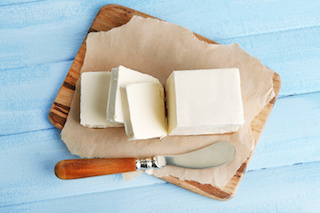 For today’s edition of Dear Mark, we’ve got a quick two-parter. First up, I discuss the results of a 2008 study into the effect of high acute intakes of various fat sources on postprandial (i.e. after eating) blood coagulation markers. Since butter came out looking not so hot, a reader wonders whether this should impact our butter consumption. Find out what I think down below. And after that, I explore infant growth charts and early weaning from breast milk in response to a new father’s question about a doctor’s suggestion.
For today’s edition of Dear Mark, we’ve got a quick two-parter. First up, I discuss the results of a 2008 study into the effect of high acute intakes of various fat sources on postprandial (i.e. after eating) blood coagulation markers. Since butter came out looking not so hot, a reader wonders whether this should impact our butter consumption. Find out what I think down below. And after that, I explore infant growth charts and early weaning from breast milk in response to a new father’s question about a doctor’s suggestion.
Let’s go:
Dear Mark,
I study health and nutrition, and the book we use (Understanding Nutrition by Whitney Rolfes, 13th edition) is all about eating less saturated fat. They cite a quite convincing study that shows that butter could promote blood clotting. I read the whole study and couldn’t find any faults using my limited abilities. The study is: “Chronic dietary fat intake modifies the postprandial response of hemostatic markers to a single fatty test meal” It appeared in the American journal of clinical nutrition. Am J Clin Nutr February 2008 vol. 87 no. 2 317-322. I’d like to hear your thoughts about it!
Kind regards,
Bram
Great question, Bram. Let’s look at this study. The researchers, as you say, were looking for dietary patterns that increase the risk of blood coagulation. It’s easy to understand why: if a blood clot blocks the flow of blood, you get a heart attack.
To start, subjects were placed into one of three diet groups for 4 weeks:
A high monounsaturated fatty acid (MUFA) diet based on olive oil – 15/47/38% protein/carb/fat, with 24% of total calories from MUFA, less than 10% from saturated fatty acids (SFA), and 4% from polyunsaturated fatty acids (PUFA), of which 0.4% came in the form of ALA omega-3.
A high SFA diet based on butter – 15/47/38% protein/carb/fat, with 22% of total calories from SFA, 12% from MUFA, and 4% from PUFA (of which 0.4% came in the form of ALA omega-3)
A high carb/omega-3 diet based on walnuts – 15/55/30% protein/carb/fat, with less than 10% from SFA, 12% from MUFA, and 8% from PUFA (of which 2% came from ALA omega-3)
After the four weeks, the subjects all tested their markers of blood clotting in a fasted state. None of the diets had a distinct effect.
Next, the researchers tested the same clotting markers immediately after a large meal resembling their assigned diets to see if the postprandial picture was different. It was:
In all dietary groups, markers of coagulation were elevated after meals. However, the butter group had worse numbers. There’s no way around that. So, avoid all butter altogether?
Not so fast.
The meal was huge, comprising roughly half to 2/3 the total number of calories they typically ate in a day. All groups felt the effects, with coagulation biomarkers going up across the board. So olive oil and walnuts also “could promote blood clotting” along with butter, provided you eat enough calories in a sitting.
The butter group ate about a quarter to a third of a stick of butter with their meal. Is that a typical way to eat butter? It’s definitely way more than I use in a sitting.
The butter group consumed very little omega-3, just 0.4% of calories. And what they did consume came from alpha linoleic acid, the less effective plant form of omega-3. Having a little salmon with your butter – or perhaps a little butter with your salmon – will probably make a big difference.
Most importantly (in my opinion), the butter group ate about half their calories as carbs – far from low-carb. As I’ve already covered, large amounts of saturated fat don’t pair well with large doses of carbs. You can definitely get away with eating carbs and fat together, especially if you’re lean and active, but when you’re eating 2/3 of your daily calories in a single sitting, things get hairy. That’s a huge amount of food to deal with at once. And energy overload (of any source) will increase insulin resistance, which is frequently linked to increased blood coagulation. Combining palmitic acid (in butter) with carbohydrate makes it even worse and amplifies the insulin response.
The specific foods included in the diets (besides the fat sources) weren’t available in the study text, so I can’t know for sure, but the researchers do mention that the carbs came from bread. In women, a recent study found that while butter used on bread increased the risk of heart attack, butter used for cooking did not increase the risk.
Other lifestyle factors modify the effect. Berries consumed with a high-fat meal have been shown to reduce the increased postprandial coagulation markers, and regular exercise (or simply being fit) also reduces the postprandial coagulation response; I bet going for a 20 minute walk after meals would also be beneficial. Berries and regular exercise are standard Primal fare, wouldn’t you say?
I know it’s fun to brag about heroic doses of grass-fed butter. And thumbing your nose at the health authorities who caution against even a single pat of the stuff by actually buying and eating butter is important. But be careful not to go too far in the other direction. Just because some butter is safe and health-promoting doesn’t mean a half stick as a meal is safe and health-promoting.
Does anyone really need a half stick of butter with (or as) their meal? Aren’t there other things a person can be eating with butter instead of just piling on more and more?
Instead:
Eat a variety of foods, including colorful fruits and vegetables.
Don’t just eat butter. Eat olive oil. Eat fatty fish. Eat nuts. And yes, eat butter. Make sure it’s pastured, as this truly does make a difference in the metabolic response.
Exercise regularly and move frequently.
Don’t eat huge meals representing 2/3 your daily caloric allotment of mostly fat and carbs. That’s basically the Standard American Diet.
Tread carefully on the extremes. If you’re going to eat a stick of butter, you’re better off keeping carbs very low. If you’re going to eat a bag of potatoes, you’re better off keeping fat very low.
Hope that helps!
My wife and I both eat primaly and our kids are rapidly becoming more primal! Our youngest is currently 4 months and being breastfed, however weight gain is very slow and our health visitor is recommending early weaning. Any thoughts on this and weaning a baby primally in general?
David
Congratulations!
You may have nothing to worry about. Exclusively breastfed babies travel a different growth trajectory than formula-fed babies, and the growth charts used by doctors may not be up to date. The chart from the World Health Organization is ideal for breastfed babies, as it reflects growth patterns in children who were breastfed for at least 4 months and usually up through a full year.
The 1977 growth chart used babies who were weaned at 4 months and primarily fed formula. That’s not representative of a breastfed baby, whose normal growth slows down right around month three.
In its own FAQ, the CDC recommends against using the CDC growth chart for breastfed babies and admits that the WHO chart shows how “infants should grow rather than simply do grow.”
Make sure your health visitor is referencing the WHO growth chart before proceeding.
If you do go with early weaning, consider implementing some foods rich in prebiotic fibers to reduce the risk of food intolerances. In one recent study, researchers used prebiotics during the post-weaning period to induce tolerance in a mouse model of allergy (where allergies are basically guaranteed). Both galactooligosaccharides (GOS) and inulin were effective. GOS resemble (and approximate the effect of) the prebiotics found in breastmilk, while inulin – found in foods like leeks, jerusalem artichokes, and jicama – is an indigestible blend of fructose polymers that your gut bacteria break down into short chain fatty acids. If your kid’s not into leeks, jerusalem artichokes, and jicama, you can always buy supplements of both GOS and inulin and add a small bit to food they do like. Smoothies, milk, yogurt, and other amenable food mediums will all work.
Oh, and if you do wean, keep the breast milk flowing! That will also improve your child’s tolerance of newly introduced foods and it’s actually the recommended path by most experts.
Thanks for reading, everyone. Be sure to chime in with your own responses if you have anything to add to (or counter) what I wrote!




November 16, 2014
Weekend Link Love – Edition 322
 Research of the Week
Research of the WeekIn Taekwondo athletes, a ketogenic diet improved physical performance (PDF).
Using a foam roller reduces arterial stiffness and improves endothelial function.
Playing action video games may improve general learning capacity, not just game-specific learning performance.
Ginger is probably effective for patients with osteoarthritis.
New Primal Blueprint Podcasts
Episode 42: Ask the Primal Doctor – Q&A with Dr. Cate Shanahan: Dr. Cate returns to the podcast to talk a little bit about her history working with rural Hawaiians eating their traditional diets, how that experience shaped her approach to medicine, and whether or not the mainstream medical community is shifting toward a more ancestral approach (even if they don’t quite know it).
Each week, select Mark’s Daily Apple blog posts are prepared as Primal Blueprint Podcasts. Need to catch up on reading, but don’t have the time? Prefer to listen to articles while on the go? Check out the new blog post podcasts below, and subscribe to the Primal Blueprint Podcast here so you never miss an episode.
What’s Living on Your Skin?
Expert Certification Adds Accreditation and Advisory Board
Interesting Blog Posts
As violent video game consumption increased, actual real life violence decreased.
Several sets of heavy leg presses performed right before cycling improved cyclists’ subsequent cycling performance by 6%. Researchers aren’t exactly sure why, as neither VO2 max nor lactic acid levels were significantly affected.
Media, Schmedia
Anne Hathaway goes from vegan to paleo. Good switch.
The New Yorker covers grass-fed meat (and, somewhat indirectly, ancestral health).
Everything Else
There may actually be four chronotypes, not just two.
Would you do a 21-day no sitting challenge? This person is.
A longtime anti-saturated fat guy has a public change of heart (PDF).
Check out (OFFTIME), an app that lets you unplug from your smartphone.
I’m honored to be featured in a new recipe ebook out this week. Check out The Best Paleo Recipes of 2014, featuring 150 stunning and delicious recipes from your favorite bloggers. Sale offer ends Monday, November 17th at 11:59 PM EST.
Recipe Corner
I don’t know about you guys, but I’m always out of onion powder. Why not make my own (and use red onions in the process)?
The cross-rib roast is underrated (and sliced thin, actually makes a good inexpensive steak). Here’s a nice way to cook it.
Time Capsule
One year ago (Nov 16 – Nov 22)
Blue Light: Better Than Coffee? – It certainly doesn’t taste as good, but blue light may rival coffee for increasing alertness.
The Wonderful, Pungent World of Asian Fermented Condiments (and Why You Should Visit) – There’s way more than just fish sauce out there.
Comment of the Week
We are the petri dish….
– Indeed we are.




November 15, 2014
Bacon Trail Mix
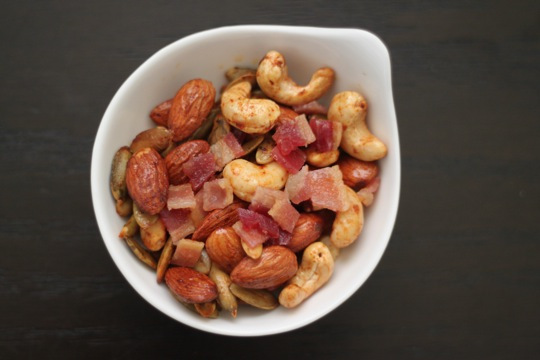 Trail mix is usually a blend of sweet and salty ingredients, but it doesn’t have to be. This trail mix is savory all the way, combining roasted nuts and seeds with crispy bits of bacon and the delicious lard it renders.
Trail mix is usually a blend of sweet and salty ingredients, but it doesn’t have to be. This trail mix is savory all the way, combining roasted nuts and seeds with crispy bits of bacon and the delicious lard it renders.
Here, cashews, almonds and pumpkin seeds are flavored with coconut aminos, smoked paprika and a pinch of cayenne – but you can use your own favorite nut/seed combination. It’s also easy to imagine adding some finely chopped, fresh rosemary or other spices to the mix.
This addictive snack is almost too dangerous to make when you’re home alone. Instead, share it with friends. Make a double batch of bacon trail mix, set it out at a party and watch it fly.
Servings: 4
Time in the Kitchen: 1 hour
Ingredients:
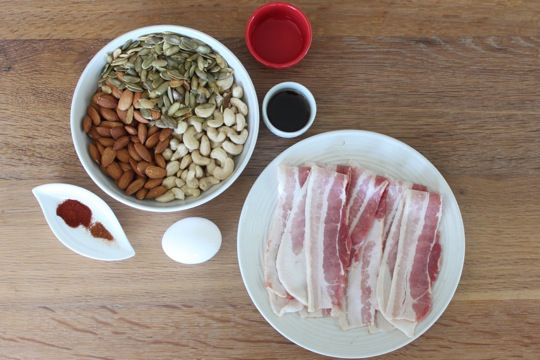
4 slices bacon
1 egg white*
1 tablespoon water* (15 ml)
1 cup raw unsalted cashews (150 g)
1 cup raw unsalted almonds (150 g)
1/2 cup raw pepitas (75 g)
2 tablespoons coconut aminos (30 ml)
3/4 teaspoon smoked paprika (4 ml)
1/8 teaspoon (or more) cayenne (a pinch)
Instructions:
*The egg white whisked with water is optional, but helps spices adhere better.
Line a large baking sheet with foil. Lay the strips of bacon out, spaced so they’re not touching. Put the pan in the oven and turn the temperature up to 400 ºF/205 ºC (no need to preheat).
Cook bacon 20 to 25 minutes until crispy. Use tongs to move the bacon onto a plate to cool. Pour the bacon grease out of the pan and set aside.
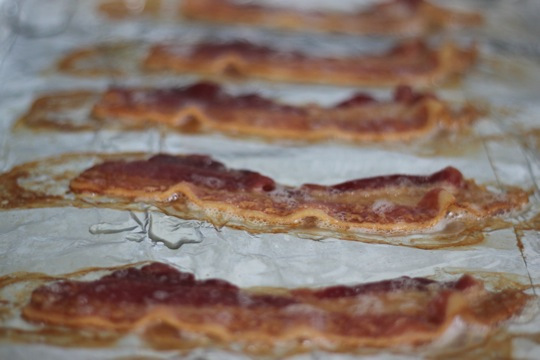
Turn the oven temperature down to 300 ºF/150 ºC.
In a large bowl, whisk the egg white and water until frothy. Add in the nuts and seeds, and mix well to coat. Drain the nuts and seeds in a colander for a few minutes, stirring and pressing with a rubber spatula a few times, so excess egg white drips off.

Return the nuts and seeds to the large bowl and add the coconut aminos, paprika and cayenne. Mix well. Pour in the bacon grease and mix well again.
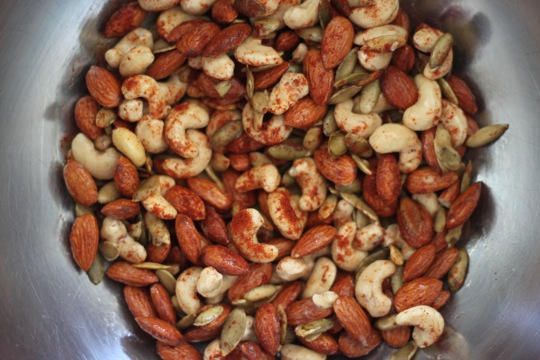
Spread the nuts out on the same baking sheet the bacon was cooked on.
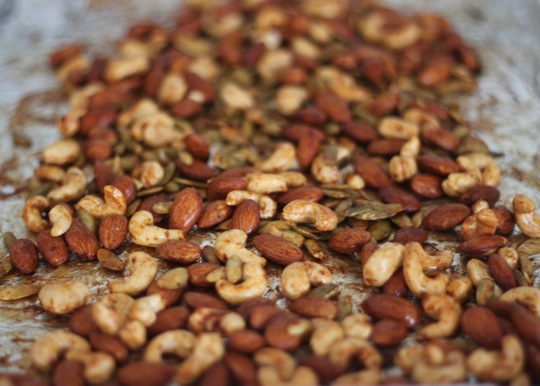
Roast 30 minutes, mixing once.
Remove from the oven and immediately scrape onto a large plate or pan to cool (or it will stick to the aluminum foil). Chop the bacon up into small pieces and combine with the cooled nuts and seeds. Let the nuts cool completely before storing in an airtight container. If not eating within 24 hours, store the bacon trail mix in the refrigerator.
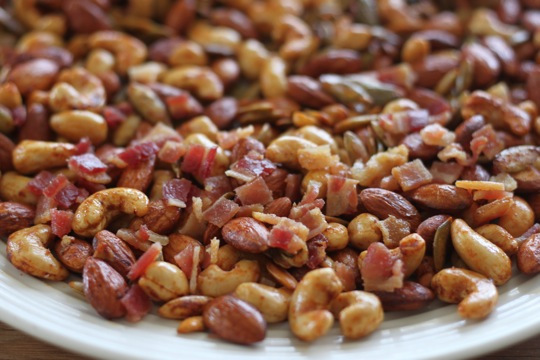
Not Sure What to Eat? Get the Primal Blueprint Meal Plan for Shopping Lists and Recipes Delivered Directly to Your Inbox Each Week



November 14, 2014
How Not to Train for an Endurance Event
It’s Friday, everyone! And that means another Primal Blueprint Real Life Story from a Mark’s Daily Apple reader. If you have your own success story and would like to share it with me and the Mark’s Daily Apple community please contact me here. I’ll continue to publish these each Friday as long as they keep coming in. Thank you for reading!
 What if I stopped procrastinating on writing my story? Why haven’t I written it so far? Is it worth it? Is it boring? Maybe yes or maybe no. If I don’t start, I think I will never know. As I fly from Houston to Europe, I’m getting it done. So what do I want you to take away after reading these pages? I want you to know my story first, then relate it to your own journey and why you are reading another story about weight loss. Is my story only about weight loss? I’ll let you decide.
What if I stopped procrastinating on writing my story? Why haven’t I written it so far? Is it worth it? Is it boring? Maybe yes or maybe no. If I don’t start, I think I will never know. As I fly from Houston to Europe, I’m getting it done. So what do I want you to take away after reading these pages? I want you to know my story first, then relate it to your own journey and why you are reading another story about weight loss. Is my story only about weight loss? I’ll let you decide.
First, I grew up in South America—a place where the culture encourages people to over eat corn, rice, and wheat flour (pretty much lots of refined carbohydrates). So when I was growing up, I was never skinny. I had a few extra pounds, but I was active enough to be strong. When I was 14, I fell in love with mountain biking and mountain trekking. The two activities became my sports and I would do them three to five times a week. But for my diet, I was still eating lots of food. So what was the problem? I was in my late teens, strong, never slim, but not fat. The catch was, the problems came later.
Fast forward five to 10 years, and I was in my mid to late 20’s where I began facing high cholesterol. But I thought, “Isn’t that genetic? I must not be able to change it.” Mind you that in those 10 years I had also managed to put on 30 to 45 pounds of weight. Diet after diet, I would loose 10 to 15 pounds, then regain all the weight and then some.
Another nine years went by without any major changes to my diet. All the while, I still thought biking was my perfect exercise, although I kept on the 35 to 45 pounds of excess weight. You see, I’m 5′ 11″ and when I was 18 years old I was 182 lbs. But by the time I was 39, I had reached 217 lbs. What just happened? How did I do that to myself? Well, it turns out it’s not so tough if you eat rice every day, pasta at night, cereal and bread in the morning, and couple that with hardcore biking. It was a complete recipe for disaster.

It was the end of 2012. I had signed up to bike the MS150, which is a road bike event that goes from Houston to Austin in two days. I thought that if I set a hefty goal of biking 160+ miles in two days, I would be able to drop weight. So I was determined to start road biking more than mountain biking.
One thing I have not told you about me is that I’m an engineer. To say that engineers love data is an understatement. I charted blood test data in time, monitored my heart rate during all my trainings, recorded map and mileage data, etc. You get the picture. I had a lot of cool charts and numbers. But the only number that never seemed to go down was my body fat percentage.
As I was reading about training for the MS150, the more it became evident that I had to shift my focus from losing weight to decreasing my body fat percentage. Why? Because I had 32% body fat. I don’t want to go too heavily into the math of it, but here’s a little trick. Grab the number 32 and imagine a point to the right of it. If you do this, you’ll get 32.00. Now, grab that point and slide it to the left two spaces. The number then becomes 0.3200. If you take away those two zeros to the right, you get 0.32. Now grab my total weight at the time, which was 217 lbs, and multiply it by 0.32. That breaks down to 217 lbs x 0.32, which equals 69.44 lbs. What did I just do? I gave you the total amount of fat that I was carrying in my body. I once grabbed a plastic bag and filled it with water until the weight hit 69 lbs. Wow! That was a lot of fat I was carrying!
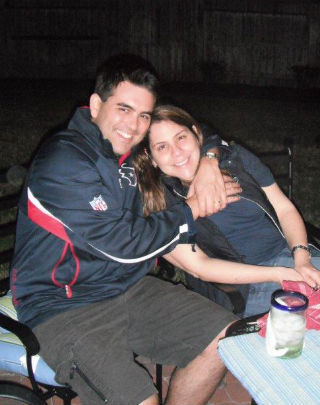 So with a new goal of decreasing my body fat percentage—because a healthy one should be around 12 to 16%—I needed to drop around 30 pounds. I was ready! So there I was, training for my endurance bike ride. After 10 or more rides, were I would ride anywhere from 30 to 75 miles, something strange started to happen. My great charts were showing my muscle mass was dropping and I was gaining fat! I thought, “How is this possible?” I was killing myself riding for seven hours at a super high rate and I was gaining weight. Come on! I started having an incredible thirst all the time, so I went to the doctor. But all my numbers were normal, with the exception that my cholesterol was high.
So with a new goal of decreasing my body fat percentage—because a healthy one should be around 12 to 16%—I needed to drop around 30 pounds. I was ready! So there I was, training for my endurance bike ride. After 10 or more rides, were I would ride anywhere from 30 to 75 miles, something strange started to happen. My great charts were showing my muscle mass was dropping and I was gaining fat! I thought, “How is this possible?” I was killing myself riding for seven hours at a super high rate and I was gaining weight. Come on! I started having an incredible thirst all the time, so I went to the doctor. But all my numbers were normal, with the exception that my cholesterol was high.
Long story short, I stopped training for the MS150. I had done something wrong. The thirst went away 10 days after I had stopped training so hard. I had all the data and charts in hand, but I could not explain what happened. In all these rides my average heart rate would run around 150 to a 165 beats per minute (bpm). I calculated my maximum heart rate by subtracting my age (39) by 220. So my max heart rate should have been 181 bpm.
And if you study how heart rate affects fat burning in the body, according to the literature, I was training above my anaerobic threshold. If you train above this limit (which varies for every person) you burn zero fat. There you go—I was demoralized a bit to say the least. I had done all that training, for essentially nothing, and I was feeling bad.
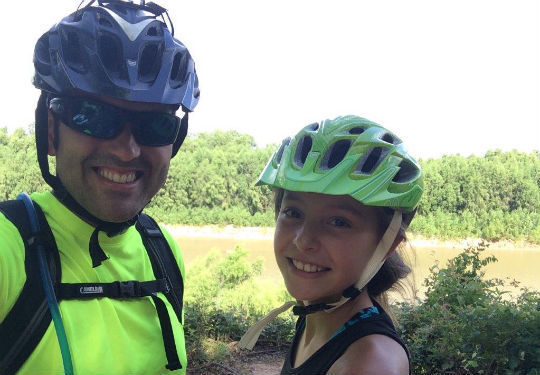
A few months went by. One day around September, 2013 I had blood work done at the doctor. There he dropped the D bomb. My A1C glucose had steadily increased throughout the years, and my cholesterol was only controlled by using statins. Furthermore, I had low testosterone. He told me that if I did not reverse this, I would have diabetes in a couple of years. That was a shock. I had a lot of science working for me, but unfortunately I had waited until the last minute to do something with it.
That’s when I saw a seminar by Dr. Pamela Peeke who was speaking about sugar addiction and the sitting disease. Also, at that time, my niece came to live with us. She was doing the paleo diet. I have to say, I was very skeptical when I heard about it. Reading her material got me to ditch sugar and processed foods. Then, while I was researching the paleo diet, I came across The Primal Blueprint. After reading the book and hundreds of threads on Mark’s blog, it sank into me: I had to try this.
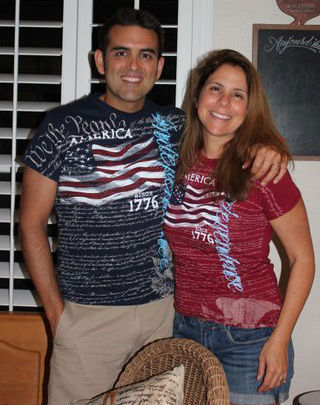 I started in October, 2013 at 217 lbs with 32% body fat. Today as I write this, I have achieved a weight of 180 lbs and my body fat hovers around 14 to 16%. So how did I loose all that body fat and overall weight? Dr. Peeke’s book, The Hunger Fix, convinced me of the real sugar addiction and how my brain was hooked on sugar. Her 3M approach (mind, mouth and muscle) made a lot of sense. I had to work on my mind first. The Primal Blueprint showed me the path to proper training and nutrition. These are the things I did:
I started in October, 2013 at 217 lbs with 32% body fat. Today as I write this, I have achieved a weight of 180 lbs and my body fat hovers around 14 to 16%. So how did I loose all that body fat and overall weight? Dr. Peeke’s book, The Hunger Fix, convinced me of the real sugar addiction and how my brain was hooked on sugar. Her 3M approach (mind, mouth and muscle) made a lot of sense. I had to work on my mind first. The Primal Blueprint showed me the path to proper training and nutrition. These are the things I did:
1. I went full primal/paleo cold turkey from day one.
I started eating meats, vegetables, nuts and fruits. Between my wife and I, we researched a lot of recipes. It’s amazing the amount of information out there. There are a lot of folk that publish recipes on Instagram, which is an excellent source of information. I used almond flour, coconut flour, ghee, coconut fat, avocado oil, honey and so many other ingredients.
2. I stopped hard cardio completely.
That meant no more long hard mountain biking sessions. If I went for a walk or light jog, I would pay attention not to go above 145 bpm.
3. I started riding my mountain bike at a lower heart rate (115 to 130 bpm) for hours—sometimes five hours at a time.
Instead of doing mountain biking trails that required a lot of effort that spike your heart rate, I started doing easier trails and riding on my neighborhood paved trails. This also required that I ditch my mountain bike buddies, but only for biking activities, after I realized that as a group we would push each other a lot, which would give me high heart rates.
4. I started doing TRX for strength training.
Suspension training is an excellent way of building the core without going to a gym or buying lots of expensive equipment.
5. After five months, I incorporated sprinting.
That seemed to jolt my body to go the extra steps to approach top fitness. I was stagnating around 185 lbs until listening to one of Mark’s podcasts that inspired me to start sprinting. It does have a reaction overall, which speeds up fat burning and make you feel stronger.
So there you go—that’s my story. Don’t wait until you get punched in the face by a doctor’s diagnosis—or worse, have a heart attack. If you have excess body fat, you need to attack that now. Define your present, accept it, move on and do it. I thank Mark for making this information available. This program changed my life forever and I am grateful.
PS: Today I’m off statins and testosterone medicine. All my values became regulated when I dropped all the fat. Plus, my heart rate has dropped around 15 to 20 bpm for the same exercises I used to do when I was overweight.
Cheers,
Mauricio




November 13, 2014
Just Walk It Off: How Walking Can Improve Your Emotional Well-Being
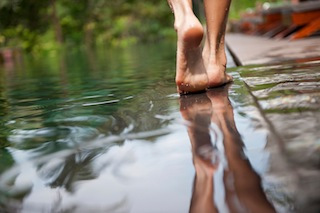 A few years ago, a friend of mine went through a particularly rough patch – one of those stretches in which life unraveled in continuous layers. She’d taken multiple trips through the emotional wringer. I was happy to catch up with her recently at a dinner party, where she was looking and feeling recovered, even content and happy again. Lingering at the table with a few of us, she ended up sharing some of the strategies that got her through that time – practices she explained she still uses when serious stress takes hold. “There were days,” she described, “when I would be so upset, so wound around a particular event and unable to let go that it was either continue wandering around the house slamming doors and making large, demonstrative arm movements as I played out the infuriating script running through my head – or just get outside and go for a long ‘$%#& you’ walk to let the bad energy burn itself out.” By the time she got back, she explained, she was dealing with embers instead of an all-out inferno. In other words, things felt manageable again. Over and over, as simple as it was, those walks were one of the main things that got her through – recognizing when she needed the release and letting the steps work their magic.
A few years ago, a friend of mine went through a particularly rough patch – one of those stretches in which life unraveled in continuous layers. She’d taken multiple trips through the emotional wringer. I was happy to catch up with her recently at a dinner party, where she was looking and feeling recovered, even content and happy again. Lingering at the table with a few of us, she ended up sharing some of the strategies that got her through that time – practices she explained she still uses when serious stress takes hold. “There were days,” she described, “when I would be so upset, so wound around a particular event and unable to let go that it was either continue wandering around the house slamming doors and making large, demonstrative arm movements as I played out the infuriating script running through my head – or just get outside and go for a long ‘$%#& you’ walk to let the bad energy burn itself out.” By the time she got back, she explained, she was dealing with embers instead of an all-out inferno. In other words, things felt manageable again. Over and over, as simple as it was, those walks were one of the main things that got her through – recognizing when she needed the release and letting the steps work their magic.
While she didn’t venture all that far from home most times – if not the streets of her neighborhood itself then maybe the beach or a nearby state park, others have clearly taken the concept to new lengths. With bestselling memoirs and movies covering the hiking quests of those who take to the trails in varying shades of grief and disorientation, the apparently hip thing to do with life’s disillusionment is to walk it off.
As I’ve gone into recently, we’re made to walk – obligated to, in fact. We can bask in the evolutionary continuum, quantify the health advantages or feel inspired by those whose daily strolls fueled their creativity and vision. On a more personal note, however, I wonder how much we turn to walking for more than exercise, more than utility. How much of our walking is emotionally-driven? How much of our walking, you could say, is about the desire to walk “away” from something?
Maybe it’s an argument with our partner or a frustrating exchange with a coworker, a difficult conversation with a son or daughter or yet another run-in with that least favorite neighbor. Aside from an actual person, maybe we’re just frazzled and frayed, blocked mentally or creatively or perhaps overwhelmed by our thoughts and need to get out from underneath them.
Our “walking away” is in the end more than metaphor. That Kierkegaard quote from a few week’s ago still stays with me: “I know of no thought so burdensome that one cannot walk away from it. But by sitting still, and the more one sits still, the closer one comes to feeling ill. Thus if one just keeps on walking, everything will be all right.”
What is it about a walk that makes space, that clears the air, that moderates our worst moods and allows us to breathe? What about a simple walk gets us in our right mind again?
I think we’ve all felt the release – from the vice grip of anger or anxiety, confusion or grief. What’s the physiological picture behind this emotional alchemy? What biochemical powers do their work, and what ends can they serve that we haven’t even considered?
First, the big picture… Beyond the euphoric runner’s high, moderate physical activity (often represented as simple walking in studies) has been shown to “soothe” us neurologically. When subjected to stress, it seems, our neurons get fired up. While regular activity boosts our production of “young” excitable neurons largely concentrated in the hippocampus – an emotional and cognitive processing center, activity also supports the abundance of neurons responsible for releasing GABA, a calming neurotransmitter that dampens brain activity and can ease anxiety.
In the larger scheme of things, research suggests, the more active we are, the less we “feel” stress. Over time, it becomes the brain’s set organization, meaning even if haven’t exercised for a few days because of illness or vacation, we’re still running off the same neurologically beneficial model.
In the short-term, we also gain from the exertion with the flush of feel-good fuzzies made possible by the enhanced secretion of various neurotransmitters as well as an increase in levels of opioids and endocannabinoids, leading some to label exercise as a psychoactive drug.
What’s more? The mood-moderating effects of exercise can set in within as little as five minutes but can last for up to twelve hours. As I’ve noted before, exercising in “green” or “blue” natural spaces offers considerably higher benefits, particularly for mood enhancement, than exercising indoors.
Beyond any biochemical measurement, walking is becoming incorporated into therapy and support models. With so-called “walk and talk therapy,” patients and therapists walk during their sessions, providing movement opportunity, which can be helpful for those whose agitation would make regular sedentary therapy conversation unduly stressful. The outdoor setting additionally makes a walk and talk format more appealing for many people, who feel they can relax more outside in the larger, natural space.
Additionally, walking bereavement groups have popped up in various corners of the U.S. and other countries. Within the groups, which are sometimes organized by hospice centers for family members who have lost a loved one or are other times less formally gathered. The benefits include the activity itself but also the social connection and kinship around it. There’s an accountability and a trust in others’ identification with their shared grief experience that many have found socially supportive and ultimately healing.
Whether we’re processing deep grief, sifting through emotional disorientation, soothing daily stress or calming down for an unpleasant interaction, walking lets us off the leash of directed thinking and interaction. It open up mental fields to explore, which perhaps can help us see other perspectives and become aware of the angles of our reactions better than we can when we’re sitting in a ball on the couch obsessing over our own negative thoughts.
In that sense, a simple outdoor walk expands not just our field of vision but our field of thinking and feeling. Ferris Jabr, writer for The New Yorker, noted that walking also helps join and even synchronize our psychological and physical energies: “Walking at our own pace creates an unadulterated feedback loop between the rhythm of our bodies and our mental state…. When we stroll, the pace of our feet naturally vacillates with our moods and the cadence of our inner speech; at the same time, we can actively change the pace of our thoughts by deliberately walking more briskly or by slowing down.”
Within the awareness of how the emotional can drive the physical, we see the potential for the opposite dynamic. The act and environment of walking takes us to a more expansive place mentally. Perhaps the physical exertion supports the emotional catharsis through full body and mind participation, providing a more potent and tangible release of tension. Walking “away” from a problem – or walking with it, we bring our troubles into a larger light and witness them in perspective to the world and community around us. Within that hour’s getaway, perhaps we experience them as lighter and more diffuse even within the mix of our own human energy.
Thanks for reading, everyone. What do you think of walking as therapy – either as a personal or clinical practice? Share your thoughts, and have a great end to the week.




November 12, 2014
What’s Living on Your Skin?
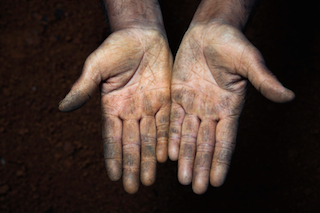 The average human body has about 1.2 square meters of skin. Scattered across and nestled in its myriad crevasses and canyons would lie trillions of bacteria, fungi, viruses, and mites. Before you shudder and reach for the bleach and a stiff scouring brush, remember the importance of cultivating and supporting the billions of bacteria living in your gut. Recall the vital roles they play (that we know about) in our health and realize that the skin microbiome isn’t any different. Although research is young, we are learning that the critters living on our skin, who number in the billions per centimeter of skin, are supposed to be there. And even though we don’t know exactly all they’re doing, we know this:
The average human body has about 1.2 square meters of skin. Scattered across and nestled in its myriad crevasses and canyons would lie trillions of bacteria, fungi, viruses, and mites. Before you shudder and reach for the bleach and a stiff scouring brush, remember the importance of cultivating and supporting the billions of bacteria living in your gut. Recall the vital roles they play (that we know about) in our health and realize that the skin microbiome isn’t any different. Although research is young, we are learning that the critters living on our skin, who number in the billions per centimeter of skin, are supposed to be there. And even though we don’t know exactly all they’re doing, we know this:
The skin microbiome isn’t an artifact of civilization or agriculture. We’ve always hosted colonies of microbes on our bodies and we’ve evolved in the context of a skin microbiome. Since our current environment is more sterile than any preceding it, our ancestral skin microbiome was almost certainly more diverse. We must exercise caution, then, when trying to extirpate our skin of “germs.”
The composition of our skin microbiome varies between areas of the body. Your left hand, for example, has a markedly different microbial community than your right hand.
Like the gut bacteria, our skin bacteria perform important roles. It’s possible, maybe even probable, that the fungi, viruses, and mites living on our skin are also necessary, but we simply don’t know enough about those critters to say for sure so today we’ll focus mainly on how the bacteria living on our skin impact us:
They regulate the skin-level immune response to allergens. For instance, in adolescents, the presence of Acinetobacter bacteria on the skin was associated with the expression of anti-inflammatory molecules and protection against allergic reactions. In a mouse model portion of the study, those same microbes directly inhibited allergic sensitization.
They control the inflammatory response. By controlling whether or not inflammatory or anti-inflammatory molecules are produced, certain skin bacteria can influence the progression and expression of autoimmune diseases like arthritis, psoriasis. Without the relevant bacteria – or with too many or too few – the inflammatory response can go unchecked.
They protect against incursions by pathogens. Staphylococcus epidermis, a common resident on our skin, produces antibacterial peptides that prevent the formation of pathogenic staphylococcus aureus (the microbe responsible for the infamous staph infection) biofilms. One experiment found that human subjects with S. epidermis in their nasal cavities were totally free of S. aureus infections.
Skin bacterial dysbiosis is involved in many skin diseases. Several lines of evidence suggest a role for skin biome dysbiosis in atopic dermatitis (PDF):
Atopic dermatitis flare-ups are characterized by lowered diversity in skin bacteria; successful resolution sees a recovery of diversity.
Atopic dermatitis flare-ups often occur in areas of low microbial diversity, like the inner knee or elbow crease.
Atopic dermatitis patients tend to have S. aureus living on their skin, crowding out commensal bacteria, taking up space, and reducing microbial diversity. The normally commensal S. epidermis may also grow overrepresented and occupy space that could be used by more diverse bacteria.
It’s not just atopic dermatitis. There are also differences between the skin microbiota in healthy patients and patients with eczema, and reduced microbial diversity is commonly found in patients with psoriasis.
The same bacteria can be helpful or harmful depending on the context (PDF). For instance:
S. epidermis is normally a commensal bacteria that produces antimicrobial peptides to protect against pathogens. If it breaches the surface of the skin, however, it can become an opportunistic pathogen. This mostly occurs in hospital settings with immunocompromised subjects, usually after surgery.
There’s also the case of Propionibacterium acnes, the bacteria most often associated with and blamed for acne. P. acnes is present on everyone’s skin, even healthy people without any visible acne. It’s often the only species present on the face and shoulders, suggesting that its presence is normal, not pathological. One helpful byproduct of normal P. acnes metabolism are short chain fatty acids which lower the skin pH and inhibit the growth and colonization of pathogenic microbes.
Some skin bacteria attract mosquitoes. Others repel them. Generally, malaria mosquitoes are attracted to people with low microbial diversity on their skin. Human skin with greater microbial diversity seems to be protective. More specifically, odors produced by the common bacterial species Pseudomonas aeruginosa are less attractive to malaria mosquitoes than odors from four other common skin microbes. This suggests a role for the skin biome in determining a person’s vulnerability to malaria, and perhaps other insect or tick-borne diseases.
It might appear as if the skin biome isn’t as “important” as the gut biome. Acne, eczema, and allergic reactions that make you itch and break out are annoying, but we don’t usually consider them life-threatening. I would caution against that position. For one thing, those conditions can really affect a person’s enjoyment of life. They show on the surface but their effects run deeper. Secondly, we have a lot to learn. We still haven’t identified most of the bacterial species living on our skin. And even the term “species” isn’t exactly accurate for bacteria, since horizontal gene transfer between disparate bacteria and other complexities have researchers questioning whether we even know how to classify bacterial species (or if they exist at all!).
But if there’s a general rule that appears to be true, it’s that greater diversity in the skin biome is preferable to less diversity.
What do we do about it, then? In a future post, I’ll explore the available evidence to figure out how to optimize the health and diversity of our skin biome.
Thanks for reading, everyone!
Prefer listening to reading? Get an audio recording of this blog post, and subscribe to the Primal Blueprint Podcast on iTunes for instant access to all past, present and future episodes here.




Mark Sisson's Blog
- Mark Sisson's profile
- 199 followers




